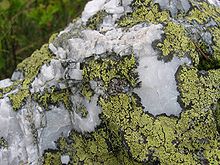
Back علم الأشنة Arabic Lixenologiya Azerbaijani Лихенология Bashkir Ліхеналогія Byelorussian Lihenologija BS Liquenologia Catalan Lichenologie Czech Lichenologie German Liquenología Spanish Lihhenoloogia Estonian

Lichenology is the branch of mycology that studies the lichens, symbiotic organisms made up of an intimate symbiotic association of a microscopic alga (or a cyanobacterium) with a filamentous fungus. Lichens are chiefly characterized by this symbiosis.
Study of lichens draws knowledge from several disciplines: mycology, phycology, microbiology and botany. Scholars of lichenology are known as lichenologists. Study of lichens is conducted by both professional and amateur lichenologists.
Methods for species identification include reference to single-access keys on lichens. An example reference work is Lichens of North America (2001) by Irwin M. Brodo, Sylvia Sharnoff and Stephen Sharnoff and that book's 2016 expansion, Keys to Lichens of North America: Revised and Expanded by the same three authors joined by Susan Laurie-Bourque.[1]
A chemical spot test can be used to detect the presence of certain lichen products which can be characteristic of a given lichen species. Some components of certain lichens may also fluoresce under ultraviolet light, providing another form of lichen identification test.
Lichenologists may also study the growth and growth rate of lichens, lichenometry, the role of lichens in nutrient cycling, the ecological role of lichens in biological soil crusts, the morphology of lichens, their anatomy and physiology, and ethnolichenology topics including the study of edible lichens. As with any other field of study, lichenology has its own set of rules for taxonomic nomenclature and its own set of other terminology.
- ^ Brodo, Irwin M; Laurie-Bourque, Susan; Sharnoff, Sylvia Duran; Sharnoff, Stephen (2016). Keys to Lichens of North America: Revised and Expanded. Yale University Press. p. 424. ISBN 978-0300195736.